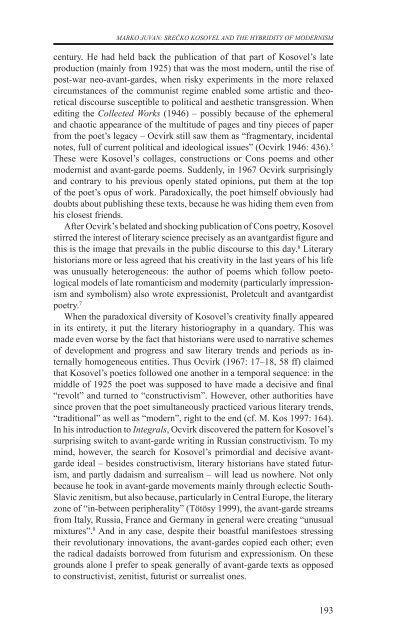razprave (pdf) - Društvo za primerjalno književnost - ZRC SAZU
razprave (pdf) - Društvo za primerjalno književnost - ZRC SAZU
razprave (pdf) - Društvo za primerjalno književnost - ZRC SAZU
- No tags were found...
Create successful ePaper yourself
Turn your PDF publications into a flip-book with our unique Google optimized e-Paper software.
MARKO JUVAN: Srečko Kosovel and the Hybridity of Modernismcentury. He had held back the publication of that part of Kosovel’s lateproduction (mainly from 1925) that was the most modern, until the rise ofpost-war neo-avant-gardes, when risky experiments in the more relaxedcircumstances of the communist regime enabled some artistic and theoreticaldiscourse susceptible to political and aesthetic transgression. Whenediting the Collected Works (1946) – possibly because of the ephemeraland chaotic appearance of the multitude of pages and tiny pieces of paperfrom the poet’s legacy – Ocvirk still saw them as “fragmentary, incidentalnotes, full of current political and ideological issues” (Ocvirk 1946: 436). 5These were Kosovel’s collages, constructions or Cons poems and othermodernist and avant-garde poems. Suddenly, in 1967 Ocvirk surprisinglyand contrary to his previous openly stated opinions, put them at the topof the poet’s opus of work. Paradoxically, the poet himself obviously haddoubts about publishing these texts, because he was hiding them even fromhis closest friends.After Ocvirk’s belated and shocking publication of Cons poetry, Kosovelstirred the interest of literary science precisely as an avantgardist figure andthis is the image that prevails in the public discourse to this day. 6 Literaryhistorians more or less agreed that his creativity in the last years of his lifewas unusually heterogeneous: the author of poems which follow poetologicalmodels of late romanticism and modernity (particularly impressionismand symbolism) also wrote expressionist, Proletcult and avantgardistpoetry. 7When the paradoxical diversity of Kosovel’s creativity finally appearedin its entirety, it put the literary historiography in a quandary. This wasmade even worse by the fact that historians were used to narrative schemesof development and progress and saw literary trends and periods as internallyhomogeneous entities. Thus Ocvirk (1967: 17–18, 58 ff) claimedthat Kosovel’s poetics followed one another in a temporal sequence: in themiddle of 1925 the poet was supposed to have made a decisive and final“revolt” and turned to “constructivism”. However, other authorities havesince proven that the poet simultaneously practiced various literary trends,“traditional” as well as “modern”, right to the end (cf. M. Kos 1997: 164).In his introduction to Integrals, Ocvirk discovered the pattern for Kosovel’ssurprising switch to avant-garde writing in Russian constructivism. To mymind, however, the search for Kosovel’s primordial and decisive avantgardeideal – besides constructivism, literary historians have stated futurism,and partly dadaism and surrealism – will lead us nowhere. Not onlybecause he took in avant-garde movements mainly through eclectic South-Slavic zenitism, but also because, particularly in Central Europe, the literaryzone of “in-between peripherality” (Tötösy 1999), the avant-garde streamsfrom Italy, Russia, France and Germany in general were creating “unusualmixtures”. 8 And in any case, despite their boastful manifestoes stressingtheir revolutionary innovations, the avant-gardes copied each other; eventhe radical dadaists borrowed from futurism and expressionism. On thesegrounds alone I prefer to speak generally of avant-garde texts as opposedto constructivist, zenitist, futurist or surrealist ones.193
















